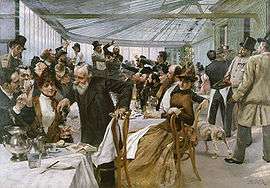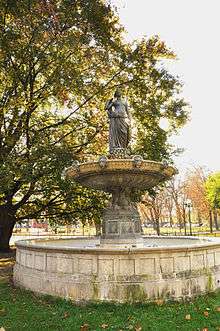Ledoyen
Coordinates: 48°51′57.9″N 2°18′59.1″E / 48.866083°N 2.316417°E
The Ledoyen is one of the oldest restaurants in Paris, situated in the square gardens in the eastern part of the Champs-Élysées in the 8th arrondissement. Its long history places it on the Champs-Élysées before the street's beautification.[1]
Situated in a two-storey pavilion with gardens, Ledoyen is considered to be one of Paris' best gourmet restaurants, and boasts three Michelin stars.[2] The building is owned by the City of Paris, but the current operator of the restaurant itself is the company "Carré des Champs Elysées", led by Alain Franchi (Chair), assisted by Serge Michel, and Mathilde Valentin (Operations Manager).
History
Initially, it began in 1779 as a very small inn named Au Dauphin.[3] It was located near the Place Louis XV (current Place de la Concorde), near the Café des Ambassadeurs (between Avenue des Champs-Élysées and the current Avenue Gabriel). At that time it was a country inn on the outskirts and cows grazed in the fields outside.[4] On 4 August 1791, Pierre-Michel Ledoyen, a son of caterers, rented it and established it as a formal restaurant.[5]

Ledoyen, a plongeur (bottlewasher) in his early years,[6] renamed the restaurant after himself in 1814, and it was owned by the Desmazures for many years. In 1842, architect Jacques Hittorff, responsible for the development of the gardens of the Champs-Élysées, transferred the restaurant to its present location.[5] Six years later, it was repaired and renovated following a fire.[7]
Today, the building walls are owned by the city of Paris. Despite its prestige and its three Michelin Star status under Christian Le Squer since 2002, the restaurant is reportedly inexpensive and serves a varied clientele.[8]
Architecture and fittings

The original building was 13 by 4 metres (43 by 13 ft), with white walls and green shutters.[3] When the restaurant was relocated in 1784 it was to a two-storey pavilion with terraced gardens,[2][5] designed in the Neoclassical style. The 1886 oil-on-canvas, Scandinavian Artists' Lunch at Cafe Ledoyen, Paris, on Varnishing Day by the Swedish painter Hugo Birger suggests something of the appearance of the restaurant in the late 19th century.[9] Its features include many huge windows, ornate ceilings,[7] and historic second floor rooms.[10] Dining areas include outdoor seating, interior salons,[11] and a 1950s style grill room.[12]
Notable patrons
During the late 18th century, it was a haunt of Louis de Saint-Just and Maximilien Robespierre and they dined there on 26 July 1794, two days before their execution.[3] Napoleon and Joséphine de Beauharnais reportedly met at the restaurant and the restaurant was also a favourite of artists and writers such as Danton, Marat, Degas, Monet, Zola, Flaubert and Guy de Maupassant.[5] A mid-19th-century account states that the restaurant was also the breakfast place of duellists, who, after shooting at each other in the Bois de Boulogne, reconciled over breakfast at Ledoyen.[13]
See also
References
- ↑ Stanford's Paris guide: with three maps, and a view of the Champs Elysées (Public domain ed.). E. Stanford. 1858. pp. 78–. Retrieved 21 January 2012.
- 1 2 Wurman, Richard Saul (23 September 2008). Access Paris. HarperCollins. pp. 140–. ISBN 978-0-06-147061-5. Retrieved 21 January 2012.
- 1 2 3 Vallois, Thirza (September 1999). Around and about Paris Vol.2: From the Guillotine to the Bastille Opera: The 8th, 9th, 10th, 11th & 12th Arrondissements. Iliad Books. p. 40. Retrieved 20 January 2012.
- ↑ Glyn, Anthony; Glyn, Susan (June 2000). The companion guide to Paris. Companion Guides. p. 83. ISBN 978-1-900639-20-0. Retrieved 20 January 2012.
- 1 2 3 4 Downes, Stephen (1 November 2006). Paris on a Plate. Pier 9. p. 133. ISBN 978-1-74045-881-8. Retrieved 20 January 2012.
- ↑ Strong, Rowland (1900). Where and how to dine in Paris: with notes on Paris hotels, waiters and their tips, Paris theatres, minor theatres, music halls, racing round Paris, etc (Public domain ed.). G. Richards. pp. 72–. Retrieved 21 January 2012.
- 1 2 Vlotides, Nina (2006). A Hedonist's Guide to Paris. A Hedonist's guide to... pp. 102–. ISBN 978-1-905428-05-2. Retrieved 21 January 2012.
- ↑ Nathaniel Newnham-Davis (January 2008). Gourmet's Guide to Europe. Applewood Books. p. 21. ISBN 978-1-4290-1266-9. Retrieved 20 January 2012.
- ↑ Lindgren, Mereth (1987). A history of Swedish art. Signum. p. 186. ISBN 978-91-85330-78-2. Retrieved 21 January 2012.
- ↑ Trefler, Caroline (29 August 2006). Fodor's 2007 Paris. Random House Digital, Inc. pp. 173–. ISBN 978-1-4000-1681-5. Retrieved 21 January 2012.
- ↑ Appletons' journal (Public domain ed.). D. Appleton and Co. 1874. pp. 658–. Retrieved 21 January 2012.
- ↑ Tillier, Alan; Spenley, Katherine (2011). DK Eyewitness Travel Guide: Paris. Penguin. pp. 313–. ISBN 978-0-7566-8505-8. Retrieved 21 January 2012.
- ↑ Paris and its environs (Public domain ed.). 1855. pp. 189–. Retrieved 21 January 2012.
External links
| Wikimedia Commons has media related to Pavillon Ledoyen. |
| ||||||